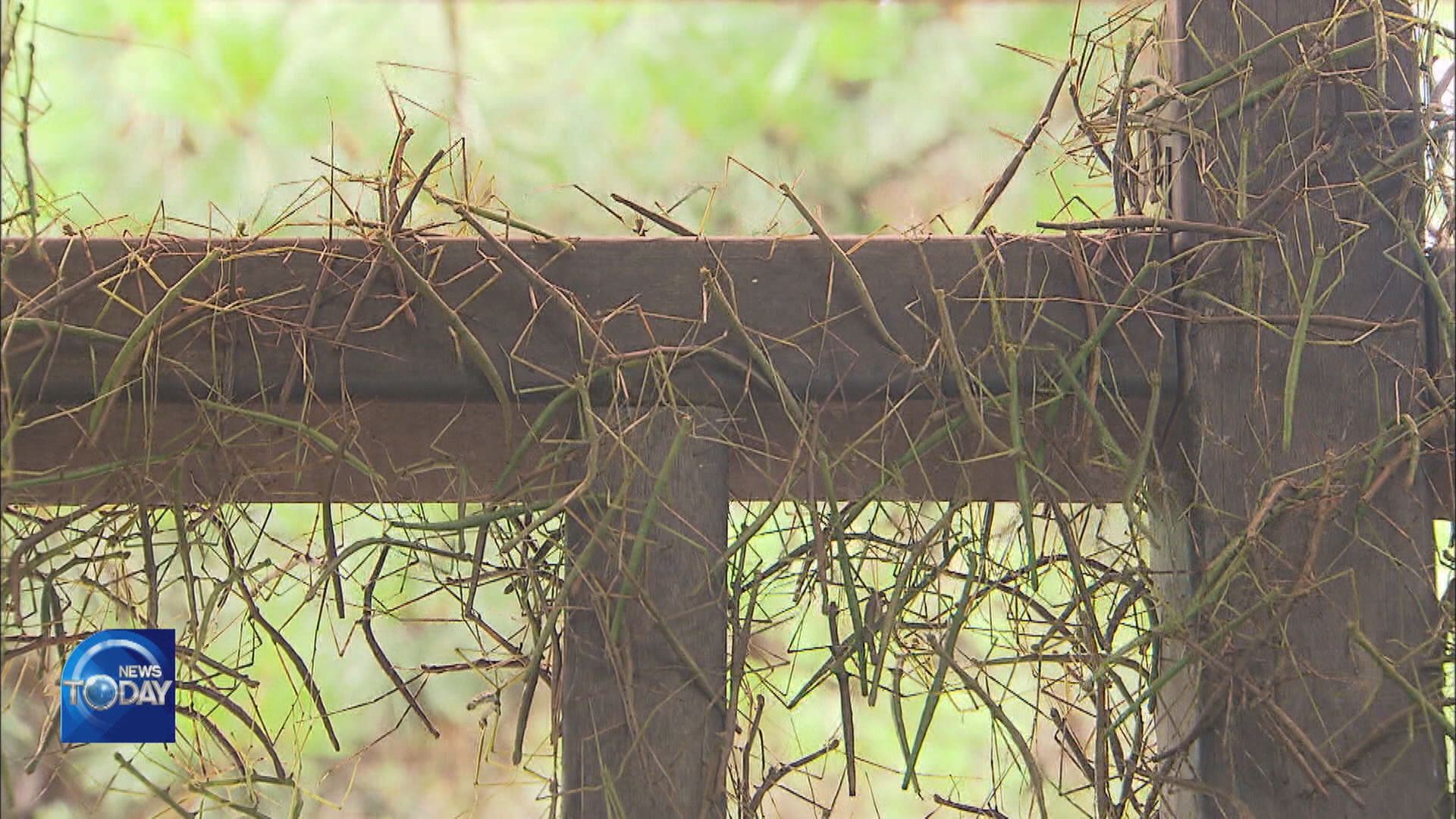STICK INSECTS TAKE OVER MOUNTAINS
입력 2021.07.22 (15:19)
수정 2021.07.22 (16:51)
읽어주기 기능은 크롬기반의
브라우저에서만 사용하실 수 있습니다.
[Anchor Lead]
Stick insects are invading the mountains in the Seoul capital area just like in last year. An unusually warm winter and the abundance of broadleaf trees in Korean mountains have provided a perfect hatching condition for this insect. But the stick insect’s nature also had a part in their proliferation.
[Pkg]
It appears to be long plant stems but they are moving. These are actually bugs known as the stick insect as they resemble tree branches. Trees, signs and even fitness equipment are covered with these insects also called the walking sticks. They squirm on the floor tangled with one another. The walking sticks have eaten up the leaves.
[Soundbite] Jeon Hye-yeong(Visitor) : "They are all over the trees and fitness equipment. It wasn’t this bad before. But now we can’t even sit on a bench because there are clusters of them."
The stick insects that exploded in numbers in Bongsan Mountain in Seoul last year seem to have spread this year to Surisan Mountain in Gunpo, Cheonggyesan Mountain in Uiwang and Geumamsan Mountain Hanam.
[Soundbite] Park Gyu-cheon(Pest Monitoring Group, Gunpo Municipal Gov’t) : "It was manageable at first we could manage with a small group of people. But now that there are so many, we have to implement pest control measures."
A warm winter caused the insect eggs’ that hibernate underground to hatch in great numbers and the abundance of broadleaf trees which they feed on also helped the insect population explode.
[Soundbite] Jung Jong-kook(Researcher, National Institute of Forest Science) : "One of the reasons for the insect’s proliferation in the capital region is the highest distribution of broadleaf trees as indicated in the national forest map."
The insects’ spawning season already began. A single female walking stick bug can lay between 600 and 700 eggs until autumn without mating. These insects lay eggs every day so constant pest control is the best way to deal with them. Stick insects are indigenous to Korea and not harmful to humans, but since they can undermine the growth of broadleaf trees, the Korea Forest Service and local governments are working together to control its population.
Stick insects are invading the mountains in the Seoul capital area just like in last year. An unusually warm winter and the abundance of broadleaf trees in Korean mountains have provided a perfect hatching condition for this insect. But the stick insect’s nature also had a part in their proliferation.
[Pkg]
It appears to be long plant stems but they are moving. These are actually bugs known as the stick insect as they resemble tree branches. Trees, signs and even fitness equipment are covered with these insects also called the walking sticks. They squirm on the floor tangled with one another. The walking sticks have eaten up the leaves.
[Soundbite] Jeon Hye-yeong(Visitor) : "They are all over the trees and fitness equipment. It wasn’t this bad before. But now we can’t even sit on a bench because there are clusters of them."
The stick insects that exploded in numbers in Bongsan Mountain in Seoul last year seem to have spread this year to Surisan Mountain in Gunpo, Cheonggyesan Mountain in Uiwang and Geumamsan Mountain Hanam.
[Soundbite] Park Gyu-cheon(Pest Monitoring Group, Gunpo Municipal Gov’t) : "It was manageable at first we could manage with a small group of people. But now that there are so many, we have to implement pest control measures."
A warm winter caused the insect eggs’ that hibernate underground to hatch in great numbers and the abundance of broadleaf trees which they feed on also helped the insect population explode.
[Soundbite] Jung Jong-kook(Researcher, National Institute of Forest Science) : "One of the reasons for the insect’s proliferation in the capital region is the highest distribution of broadleaf trees as indicated in the national forest map."
The insects’ spawning season already began. A single female walking stick bug can lay between 600 and 700 eggs until autumn without mating. These insects lay eggs every day so constant pest control is the best way to deal with them. Stick insects are indigenous to Korea and not harmful to humans, but since they can undermine the growth of broadleaf trees, the Korea Forest Service and local governments are working together to control its population.
■ 제보하기
▷ 카카오톡 : 'KBS제보' 검색, 채널 추가
▷ 전화 : 02-781-1234, 4444
▷ 이메일 : kbs1234@kbs.co.kr
▷ 유튜브, 네이버, 카카오에서도 KBS뉴스를 구독해주세요!
- STICK INSECTS TAKE OVER MOUNTAINS
-
- 입력 2021-07-22 15:19:40
- 수정2021-07-22 16:51:54

[Anchor Lead]
Stick insects are invading the mountains in the Seoul capital area just like in last year. An unusually warm winter and the abundance of broadleaf trees in Korean mountains have provided a perfect hatching condition for this insect. But the stick insect’s nature also had a part in their proliferation.
[Pkg]
It appears to be long plant stems but they are moving. These are actually bugs known as the stick insect as they resemble tree branches. Trees, signs and even fitness equipment are covered with these insects also called the walking sticks. They squirm on the floor tangled with one another. The walking sticks have eaten up the leaves.
[Soundbite] Jeon Hye-yeong(Visitor) : "They are all over the trees and fitness equipment. It wasn’t this bad before. But now we can’t even sit on a bench because there are clusters of them."
The stick insects that exploded in numbers in Bongsan Mountain in Seoul last year seem to have spread this year to Surisan Mountain in Gunpo, Cheonggyesan Mountain in Uiwang and Geumamsan Mountain Hanam.
[Soundbite] Park Gyu-cheon(Pest Monitoring Group, Gunpo Municipal Gov’t) : "It was manageable at first we could manage with a small group of people. But now that there are so many, we have to implement pest control measures."
A warm winter caused the insect eggs’ that hibernate underground to hatch in great numbers and the abundance of broadleaf trees which they feed on also helped the insect population explode.
[Soundbite] Jung Jong-kook(Researcher, National Institute of Forest Science) : "One of the reasons for the insect’s proliferation in the capital region is the highest distribution of broadleaf trees as indicated in the national forest map."
The insects’ spawning season already began. A single female walking stick bug can lay between 600 and 700 eggs until autumn without mating. These insects lay eggs every day so constant pest control is the best way to deal with them. Stick insects are indigenous to Korea and not harmful to humans, but since they can undermine the growth of broadleaf trees, the Korea Forest Service and local governments are working together to control its population.
Stick insects are invading the mountains in the Seoul capital area just like in last year. An unusually warm winter and the abundance of broadleaf trees in Korean mountains have provided a perfect hatching condition for this insect. But the stick insect’s nature also had a part in their proliferation.
[Pkg]
It appears to be long plant stems but they are moving. These are actually bugs known as the stick insect as they resemble tree branches. Trees, signs and even fitness equipment are covered with these insects also called the walking sticks. They squirm on the floor tangled with one another. The walking sticks have eaten up the leaves.
[Soundbite] Jeon Hye-yeong(Visitor) : "They are all over the trees and fitness equipment. It wasn’t this bad before. But now we can’t even sit on a bench because there are clusters of them."
The stick insects that exploded in numbers in Bongsan Mountain in Seoul last year seem to have spread this year to Surisan Mountain in Gunpo, Cheonggyesan Mountain in Uiwang and Geumamsan Mountain Hanam.
[Soundbite] Park Gyu-cheon(Pest Monitoring Group, Gunpo Municipal Gov’t) : "It was manageable at first we could manage with a small group of people. But now that there are so many, we have to implement pest control measures."
A warm winter caused the insect eggs’ that hibernate underground to hatch in great numbers and the abundance of broadleaf trees which they feed on also helped the insect population explode.
[Soundbite] Jung Jong-kook(Researcher, National Institute of Forest Science) : "One of the reasons for the insect’s proliferation in the capital region is the highest distribution of broadleaf trees as indicated in the national forest map."
The insects’ spawning season already began. A single female walking stick bug can lay between 600 and 700 eggs until autumn without mating. These insects lay eggs every day so constant pest control is the best way to deal with them. Stick insects are indigenous to Korea and not harmful to humans, but since they can undermine the growth of broadleaf trees, the Korea Forest Service and local governments are working together to control its population.
이 기사가 좋으셨다면
-
좋아요
0
-
응원해요
0
-
후속 원해요
0

















이 기사에 대한 의견을 남겨주세요.